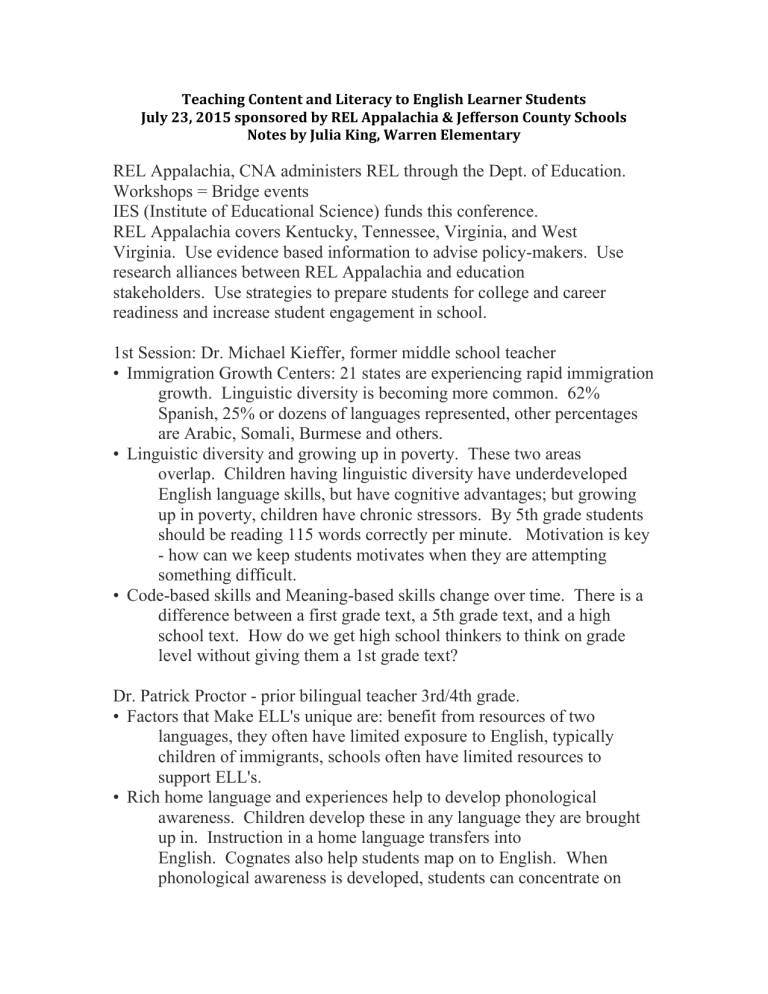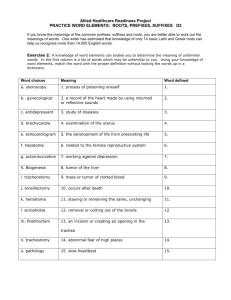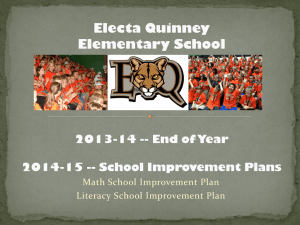Notes from the 7-23-15 Workshop

Teaching Content and Literacy to English Learner Students July 23, 2015 sponsored by REL Appalachia & Jefferson County Schools Notes by Julia King, Warren Elementary
REL Appalachia, CNA administers REL through the Dept. of Education. Workshops = Bridge events IES (Institute of Educational Science) funds this conference. REL Appalachia covers Kentucky, Tennessee, Virginia, and West Virginia. Use evidence based information to advise policy-makers. Use research alliances between REL Appalachia and education stakeholders. Use strategies to prepare students for college and career readiness and increase student engagement in school. 1st Session: Dr. Michael Kieffer, former middle school teacher • Immigration Growth Centers: 21 states are experiencing rapid immigration growth. Linguistic diversity is becoming more common. 62% Spanish, 25% or dozens of languages represented, other percentages are Arabic, Somali, Burmese and others. • Linguistic diversity and growing up in poverty. These two areas overlap. Children having linguistic diversity have underdeveloped English language skills, but have cognitive advantages; but growing up in poverty, children have chronic stressors. By 5th grade students should be reading 115 words correctly per minute. Motivation is key - how can we keep students motivates when they are attempting something difficult. • Code-based skills and Meaning-based skills change over time. There is a difference between a first grade text, a 5th grade text, and a high school text. How do we get high school thinkers to think on grade level without giving them a 1st grade text? Dr. Patrick Proctor - prior bilingual teacher 3rd/4th grade. • Factors that Make ELL's unique are: benefit from resources of two languages, they often have limited exposure to English, typically children of immigrants, schools often have limited resources to support ELL's. • Rich home language and experiences help to develop phonological awareness. Children develop these in any language they are brought up in. Instruction in a home language transfers into English. Cognates also help students map on to English. When phonological awareness is developed, students can concentrate on
using cognates to help create meaning. • Code-based and Meaning/Knowledge based factors all help with literacy development. Reading capability determines reading proficiency. (How can I, as an English Language teacher, help students' reading capability?) Focus on Oral Language development to facilitate literacy development. • Factors affecting children of immigration: schooling experience in home country, variety of home languages, cultural disconnects such as differences between parents' expectations and the school's expectation and what school is - how students DO school here in the US (example: eye contact). Psychological challenges of immigration; some students are here illegally. These factors are challenges to most students. Other challenges are that the curriculum is not designed with ELL's in mind, lack of preparation and PD for teachers, and assessments that do not provide correct information about students' skills. • Case study: Pick 2 or three (from handout packet) and discuss challenges, address needs, and other information needed. Theme: elementary - intensive instruction from oral to written expression. This is a challenge for all students. Students often write how they talk. • What are assessments telling us about the language proficiency of the students? For example, are students low in both Spanish and English language proficiency? Speaker encourages us as teachers to think critically about the assessments used to determine these scores. Think about the basic language skills students need with their language at home, because this is not necessarily academic language. Make sure assessments measure what they intend to assess. When students are assessed in their home language, they may not have the academic vocabulary needed to have a high proficiency score. ◦ Leverage whatever access the student has to the language at their level. Focus on meaning. In the lower language development, focus on vocabulary (example: Google Translate using words and language the student can already produce and then refining this using precision of words in English. Also, create a cognate chart - making sure that the students actually know what the word means in their home language so that they can use them in English. Also, explicitly teach word connections. Example: carne - carnivore.) As proficiency levels increase, help students think in the language using the vocabulary they have already developed to help them define new words.
• Teaching Academic Content and Literacy To English Learners in Elementary and Middle School - Practice Guide Panel. Book with Academic Articles best suited for Elementary and Middle School teaching practices. Also is linked to Facilitator's Guide and PLC and associated videos. This will help long-term Professional Learning Communities in schools. • This book has many recommendations: 1 2 Teach a set of academic vocabulary words intensively across several days using a variety of instructional activities. (strong) Speak, use words in context with big ideas, and write using the words. Choose a brief, engaging piece of text, as a platform for intensively teaching the vocabulary. Teach vocabulary using a depth of strategies. Use context and word parts to help students to acquire new vocabulary. Choose high-utility words that they will need to use across disciplines; choose a small set of academic vocabulary. Teach vocabulary using language domains, writing, speaking, and listening. Use student dictionaries, role-plays, use words in extended writing. Help build students' understanding using the context around the world. Use word parts to expand students' knowledge to other words that connect with the academic word being studied. Integrate oral and written English language instruction into content area teaching. (strong) Help students make sense of the content using videos, visuals, and graphic organizers. This is needed in ALL content areas. Ask whether these tools are used to "anchor" instruction? Are you creating a "shared" experience for students that they can reference when they move from watching a video to reading a more challenging text? Think about high utility words like 'analysis', and high academic words like 'photosynthesis'. How do we get students engaged in the content. Explicitly teach content-specific vocabulary, and general academic vocabulary. Provide daily opportunities for students to talk about content in pairs or small groups. Design writing opportunities for extending students' content-area learning in writing. 3 Provide regular, structured opportunities to develop written language skills. (minimal) This means that their is little research to show how students can use expressive language in written form. Writing needs to be happening and we need to experiment with how to best use this in the classroom. Reading
4 is a receptive skill, and writing is an expressive skill. 90% of talk in the classroom is teacher talk. To help students express their language, they need more opportunities to practice this. This also carries over into language; students need supports to facilitate students' entry into and continued development of writing. Use pairs and small groups to work and talk together as a precursor structuring thinking and planning before attempting to write. Length is a predictor to quality. When you see more language, you expect better quality. An exit slip can assess students' comprehension. Provide writing assignments that are anchored in content and are used to develop academic language as well as writing skills. This means teach from a genre - what do you need to know about a genre to write using that genre? Example: write a scientific procedure. There are stages of the procedure that uses steps, materials, and has a goal at the end. This uses adjectives and mapping language to objects; it also uses the imperative tense and understood 'you' (example: Pour 50mL of distilled white vinegar into the flask.) Use graphic organizers and sentence starters to support students' entry into and continued writing. Another example is: the teacher has students read Sadako and 1000 Cranes. Then has students respond in writing. Then, the teacher has the students discuss their writing and opinions with a small group. Last, the teacher has the students write again. The level of writing increased in length and quality the second time they responded to the writing prompt. A separate example is in Science: a teacher wants students to find evidence to support a claim. She gives them cards to have students identify which ones have evidence to support the claim. This helps students create discussions about which ones are the correct evidence, and the cards draw the students back into the text. These examples help students to prepare for writing in content areas. Provide small-group intervention to students struggling in areas of literacy and English language development. Use available assessment to identify struggling students. Design instruction to target students' needs. Limit group size to 3-5 students. Focus on foundational and vocabulary knowledge, listening and reading comprehension. Provide scaffolding with concepts in different contexts to make sure that students retain
information. Make sure that students have time to practice what they have learned. Breakout session: Dr. Michael Kieffer - What does it mean to know a word well? • Precision of language. Even when a word is used metaphorically, we know what the word means. We know the definition, how it functions in a sentence, and how it relates to other words. Pragmatics in linguistics means "how do the words get things done?" How do words accomplish what a speaker or writer wants them to accomplish? How we use words to accomplish the meaning we say is different from how we use words to accomplish meaning in writing. • The way we know words is that we have a web in our brain. Words are connected to other words. It is not that we know a word, it is "how well" do you know a word? ◦ • Build knowledge piece by piece: Day one - spell, sound, looks like. Day 2 - What do I already know, definition. Day 3 - meaning, how to use it to talk about the article or text. Day 4 - multiple meanings of the word, how to represent the word graphically. Day 5/6 - different word parts inside the word and their meanings, different forms of the word and how they are used. Day 7 - different meanings of the word in context, how to write and talk about the other topics. Day 8/9 - How to use the word properly and precisely in written language. • Focus on important words, words that are useful with written print. We do not talk the way we write. There are 2x's the amount of rare or uncommon words in children's books than found in speech. Reading is a valuable place to learn vocabulary. ◦ Use academic word lists - (Marzano) words that appear often across content areas, but are not apparent in everyday speech. Example: Analyze, approach, concept, constitute... have more abstract meanings, more multiple meanings, more syllables, more difficult to pronounce. Also, these academic words can be changed with Greek and Latin roots to be different words. The academic words have these roots; the everyday speech was influenced by German and Old English roots. We associate words with Greek and Latin roots with higher order language. Preparation: Start with ideas and content worth learning about and discussing. Choose complex texts that support those discussions. Make sure the texts include words worth teaching.
◦ ◦ ◦ (These are research-based approaches.) A traditional approach is to start with a list of words or a vocabulary workbook; then provide minimal context; one or two sentences. Focus on doing a smaller number of activities in greater depth. Choose target words: frequency, central to understanding, appear in other content areas, affixes, multiple meanings and uses, cross language potential (Latin/Greek roots, cognates). Think about words that are found in multiple texts. Require students to use the words to respond to oral and written assignments. ◦ We need to help students pick up and use new words (because it is difficult to teach ALL the words that ELL's are going to need to know to catch up to their peers.) Teach students to pick up new words through: Context, Word Parts (morphology), and cognates. Example: Shakespeare "invented" new words using morphology (Some say he did not necessarily invent them, he just wrote down the speech that was being used during his time). We enrich students' knowledge through morphology. The point is that if you know the word parts, you can figure out the meaning of new words. Students are then thinking metacognitively. ◦ Have students take a word, write it in context, and then write another sentence using a different form of the word. Example: investigate, investigation. (Teach syntax and proper grammatical structure, diagraming sentences, classifying words in parts of speech chart?) Have good routines to check for students' understanding: questioning, proper planning, pick out key ideas and important concepts, use exit slips.


![Word Study [1 class hour]](http://s3.studylib.net/store/data/007905774_2-53b71d303720cf6608aea934a43e9f05-300x300.png)




